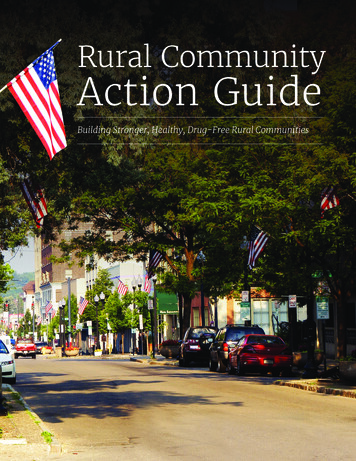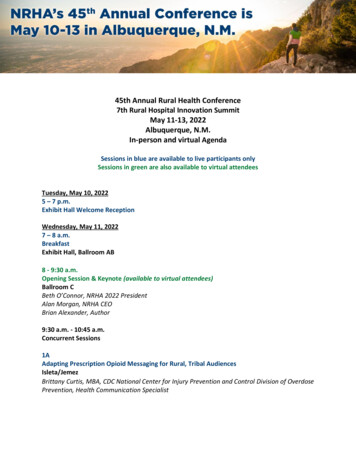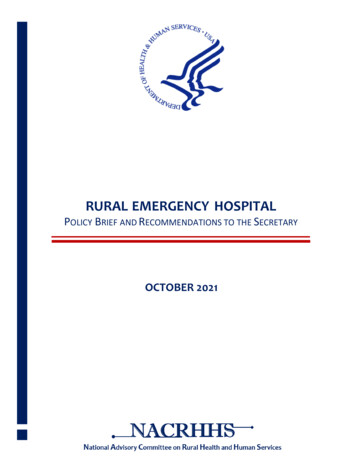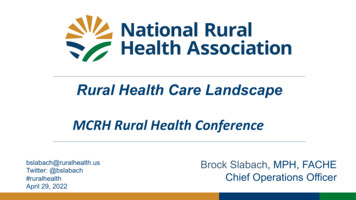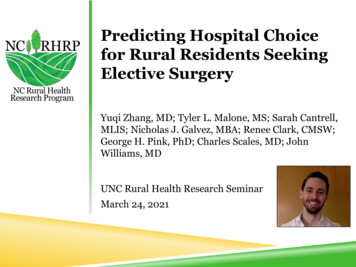
Transcription
Predicting Hospital Choicefor Rural Residents SeekingElective SurgeryYuqi Zhang, MD; Tyler L. Malone, MS; Sarah Cantrell,MLIS; Nicholas J. Galvez, MBA; Renee Clark, CMSW;George H. Pink, PhD; Charles Scales, MD; JohnWilliams, MDUNC Rural Health Research SeminarMarch 24, 2021
FundingThis study was supported by the Federal Office ofRural Health Policy (FORHP), Health Resources andServices Administration (HRSA), U.S. Department ofHealth and Human Services (HHS) under cooperativeagreement # U1GRH03714. The information,conclusions and opinions expressed in thispresentation are those of the study researchers andno endorsement by FORHP, HRSA, HHS, the NC Officeof Rural Health, or The University of North Carolina isintended or should be inferred.2
Presentation Outline1) Hospital Choice for Elective Surgery Why is it important?2) Scoping Review / Building a Conceptual Model3) Empirical Testing of the Model3
Hospital Choice for Elective Surgery – Why is it Important? Hospital choice can affect surgical outcomes- Risk of death, post-operative complications, readmissions Effect of choice on outcomes mediated by volume4
(Annotated) Fig. 1 - Birkmeyer et al., 2004(Dark Gray)Volume(LightLowGray)High Volume5
Hospital Choice for Elective Surgery – Why is it Important? Hospital choice can affect surgical outcomes-Risk of death, post-operative complications, readmissions Effect of choice on outcomes mediated by volumeLower hospital surgical volume Greater risk of adverse outcomes1-4- Example: Greater mortality rates among pancreatic resection patients atlow-volume hospitals2- However, small, rural hospitals are still capable ofproviding safe, effective surgical care for many common,less complex surgeries5-66
Hospital Choice for Elective Surgery – Why is it Important? Surgical volume affects rural hospital financial viability7-11-Surgical services account for a substantial portion of rural hospital revenue (10-40%)Greater proportion of total charges from surgery Greater operating margin Rural hospitals are particularly vulnerable to patient bypass-Bypass rates are typically around 50%12-14Bypass Lost revenue Increased risk of hospital closure15Hospital BHospital A Since 2005, 180 rural hospitals have closed (136 since 2010)16- Closures have negative downstream effects on local public health and economy17-187
Hospital Choice for Elective Surgery – Why is it Important? Surgical volume affects rural hospital financial viability7-11-Surgical services account for a substantial portion of rural hospital revenue (10-40%)Greater proportion of total charges from surgery Greater operating margin Rural hospitals are particularly vulnerable to patient bypass-Bypass rates are typically around 50%12-14Bypass Lost revenue Increased risk of hospital closure15 Since 2005, 180 rural hospitals have closed (136 since 2010)16-Closures have negative downstream effects on local public health and economy17-188
?Hospital Choice forElective SurgeryPatientOutcomesHospitalFinancial ViabilityRisk of ClosureCommunity Public Healthand Economy9
Aims of the Current Research Aim 1: Figure out what is already known and use thisinformation to build a conceptual model of hospitalchoice for rural residents seeking elective surgery.10
Aims of the Current Research Aim 1: Conduct a scoping review of studies that haveanalyzed hospital choice for rural residents seekingelective surgery.- Use the results of the scoping review to build a conceptual model Aim 2: Empirically test the Aim 1 conceptual model11
Aim 1: Scoping Review / Build Conceptual ModelSourced from JBI Manual for Evidence Synthesis and Munn et al., 20181912
Aim 1: Scoping Review / Build Conceptual ModelResearch QuestionWhat are the factors that have been proposed toaffect hospital choice among rural residents seekingelective surgery?13
Aim 1: Scoping Review / Build Conceptual ModelEligibility Criteria- Rural residents of the United States- Residents seeking elective surgeryNo transfer hospital visits or visits preceded by EMS transportation- Data from 2011-Present (i.e., post-ACA)Captures recent trends in insurance, information availability, systemaffiliation2014
Aim 1: Scoping Review / Build Conceptual ModelSearch Strategy- Locate published and unpublished studies throughsearches of MEDLINE, EMBASE, and Web of Science- Key search concepts included ”rural,” “surgery,” and“bypass/choice behavior”- Sarah Cantrell (MLIS) oversaw the search process15
Aim 1: Scoping Review / Build Conceptual ModelEvidence Selection- Found citations were uploaded into CovidenceCovidence is a literature review screening software tool- Covidence identifies and removes duplicate citations- Title / Abstract screening16
Aim 1: Scoping Review / Build Conceptual ModelI vote yes.I vote yes.17
Aim 1: Scoping Review / Build Conceptual ModelI vote no.I vote no.18
Aim 1: Scoping Review / Build Conceptual ModelI vote yes.I vote no.I vote no.19
Aim 1: Scoping Review / Build Conceptual ModelEvidence Selection- Found citations were uploaded into CovidenceCovidence is a literature review screening software tool- Covidence identifies and removes duplicate citations- Title / Abstract screening based on eligibility criteria- Full text screening based on eligibility criteria20
Aim 1: Scoping Review / Build Conceptual ModelInitial Results21
22
23
24
25
26
Data SourcesSurgery TypesAnalytic Methods HCUP SID forCO, NC, VT, WI All inpatient andoutpatientelectivesurgeries Descriptivestatistics All inpatient andoutpatientelectivesurgeries DescriptivestatisticsResultsWeigel et al.2018Weigel et al.2017Aim 1: Scoping Review / Build Conceptual Model 2011 HCUP SID forIowa 2011 Patients who wereyounger, male,African American,privately insured,and more medicallycomplex were morelikely to bypass. Hospitals with localgeneral surgeons,orthopedicsurgeons,urologists, orophthalmologistswere less likely tobe bypassed. 27 Logistic regression Logistic regression
Data SourcesSurgery TypesAnalytic MethodsResultsWeigel et al.2018Weigel et al.2017Matthews et al.2020Aim 1: Scoping Review / Build ConceptualModel Positive association Iowa CancerRegistry Elective surgeryfor colon orrectal cancer 2010-2014 HCUP SID forCO, NC, VT, WI 2011 HCUP SID forIowa 2011 Descriptivestatisticsbetween level ofrurality and numberof hospitalsbypassed Cox ProportionalHazards Models All inpatient andoutpatientelectivesurgeries Descriptivestatistics All inpatient andoutpatientelectivesurgeries Descriptivestatistics Rural patients morelikely to chooseaccredited hospitals Patients who wereyounger, male,African American,privately insured,and more medicallycomplex were morelikely to bypass. Hospitals with localgeneral surgeons,orthopedicsurgeons,urologists, orophthalmologistswere less likely tobe bypassed. 28 Logistic regression Logistic regression
Data SourcesSurgery TypesAnalytic MethodsResultsWeigel et al.2018Weigel et al.2017Matthews et al.2020Aim 1: Scoping Review / Build ConceptualModel Positive association Iowa CancerRegistry Elective surgeryfor colon orrectal cancer 2010-2014 HCUP SID forCO, NC, VT, WI 2011 HCUP SID forIowa 2011 Descriptivestatisticsbetween level ofrurality and numberof hospitalsbypassed Cox ProportionalHazards Models All inpatient andoutpatientelectivesurgeries Descriptivestatistics All inpatient andoutpatientelectivesurgeries Descriptivestatistics Rural patients morelikely to chooseaccredited hospitals Patients who wereyounger, male,African American,privately insured,and more medicallycomplex were morelikely to bypass. Hospitals with localgeneral surgeons,orthopedicsurgeons,urologists, orophthalmologistswere less likely tobe bypassed. 29 Logistic regression Logistic regression
Data SourcesSurgery TypesAnalytic MethodsResultsWeigel et al.2018Weigel et al.2017Matthews et al.2020Aim 1: Scoping Review / Build ConceptualModel Positive association Iowa CancerRegistry Elective surgeryfor colon orrectal cancer 2010-2014 HCUP SID forCO, NC, VT, WI 2011 HCUP SID forIowa 2011 Descriptivestatisticsbetween level ofrurality and numberof hospitalsbypassed Cox ProportionalHazards Models All inpatient andoutpatientelectivesurgeries Descriptivestatistics All inpatient andoutpatientelectivesurgeries Descriptivestatistics Rural patients morelikely to chooseaccredited hospitals Patients who wereyounger, male,African American,privately insured,and more medicallycomplex were morelikely to bypass. Hospitals with localgeneral surgeons,orthopedicsurgeons,urologists, orophthalmologistswere less likely tobe bypassed. 30 Logistic regression Logistic regression
PredictorEffect onMatthews et al. Weigel et al. Weigel et al.Bypass Probability202020172018Aim 1: Scoping Review / Build Conceptual Model31
PredictorEffect onMatthews et al. Weigel et al. Weigel et al.Bypass Probability202020172018Aim 1: Scoping Review / Build Conceptual ModelPatient rurality increasesPatient age increasesXXX32
PredictorEffect onMatthews et al. Weigel et al. Weigel et al.Bypass Probability202020172018Aim 1: Scoping Review / Build Conceptual ModelPatient rurality increasesXPatient age increasesXXPatient is privately insuredXXPatient medical complexityincreasesXXLocal hospital volumeincreasesXXLocal hospital is part of asystemLocal hospital is accreditedLocal hospital employslocal surgeonsXXX33
Aim 1: Scoping Review / Build Conceptual Model Hospital choice appears to be a function of both hospital andpatient characteristics Opportunities for new research include exploration of:--Additional states, geographic regionsData from 2014 or laterSpecific surgery typesAdditional hospital-level or patient-level predictors Remaining tasks for Aim 1:-Finalize data extractionFinalize conceptual modelPrepare and submit journal manuscript34
Aim 2: Empirical Testing of the Conceptual ons/128235
Aim 2: Empirical Testing of the Conceptual Model Study Design: Retrospective, observational study Sample: Rural residents receiving elective inpatient surgery-Surgery type will be determined from ICD codes Data: State Inpatient Databases (SID) for 2014-2016-SID provided by the Healthcare Cost and Utilization Project (HCUP), which issponsored by the Agency for Healthcare Research and Quality (AHRQ)36
Available States: Arizona, Colorado, Florida, Iowa, Kentucky, Minnesota, Nebraska, New Jersey,New York, North Carolina, Oregon, Rhode Island, Utah, Vermont, Washington, Wisconsin 37
Aim 2: Empirical Testing of the Conceptual Model Dependent Variable: Hospital choice-E.g., bypass vs. local hospital Independent Variables: Informed by conceptual model-Will include both hospital-level and patient-level characteristics-E.g., hospital size and distance from patient, patient insurance status, patient age Analysis: Multivariable regression-Options include linear probability models, logistic regression, mixed logit models-Analysis can be stratified by surgery type38
That’s all, folks!Stay tuned for more!39
References1. Basu, J. (2005). Severity of illness, race, and choice of local versus distant hospitals among the elderly. J Health Care Poor Underserved,16(2), 391-405. doi:10.1353/hpu.2005.00232. Birkmeyer, J. D., Siewers, A. E., Finlayson, et al. (2002). Hospital volume and surgical mortality in the United States. N Engl J Med, 346(15),1128-1137. doi:10.1056/NEJMsa0123373. Birkmeyer, J. D., & Dimick, J. B. (2004). Potential benefits of the new Leapfrog standards: effect of process and outcomes measures.Surgery, 135(6), 569-575. doi:10.1016/j.surg.2004.03.0044. Milstein, A., Galvin, R. S., Delbanco, S. F., Salber, P., & Buck, C. R., Jr. (2000). Improving the safety of health care: the leapfrog initiative. EffClin Pract, 3(6), 313-316. Retrieved from https://www.ncbi.nlm.nih.gov/pubmed/111515345. Ibrahim, A. M., Hughes, T. G., Thumma, J. R., & Dimick, J. B. (2016). Association of Hospital Critical Access Status With Surgical Outcomesand Expenditures Among Medicare Beneficiaries. JAMA, 315(19), 2095-2103. doi:10.1001/jama.2016.56186. Gadzinski, A. J., Dimick, J. B., Ye, Z., & Miller, D. C. (2013). Utilization and outcomes of inpatient surgical care at critical access hospitals inthe United States. JAMA Surg, 148(7), 589-596. doi:10.1001/jamasurg.2013.12247. Karim, S., Holmes, G. M., & Pink, G. H. (2015). The Effect of Surgery on the Profitability of Rural Hospitals. Journal of Health Care Finance,41(4).8. Chappel A. R., Zuckerman, R. S., & Finlayson, S. R. (2006). Small rural hospitals and high-risk operatings: how would regionalization affectsurgical volume and hospital revenue? J Am Coll Surg, 203, 599-604. doi: 10.1016/j.jamcollsurg.2006.07.009.9. Doty, B. & Zuckerman, R. (2009). Rural surgery: framing the issues. Surg Clin North Am, 89, 1279-1284. doi: 10.1016/j.suc.2009.09.010.10. Gold, M.S., Zuckerman, R., Dietz, P., et al. (2004). Cooperstown surgeons throw a pitch for rural surgery. Bull Am Coll Surg, 89, 16-20, 50.40
References11. Williamson Jr, H. A., Hart, L. G., Pirani, M. J., et al. (1994). Rural hospital inpatient surgical volume: cutting-edge service or operating on the margin? JRural Health, 10, 16-25. doi: 10.1111/j.1748-0361.1994.tb00204.x.12. Malone, T. L. & Holmes, G. M. (2020). Patterns of Hospital Bypass and Inpatient Care-Seeking by Rural Residents. North Carolina Rural HealthResearch Program. Retrieved from: 28213. Weigel, P. A. M., Ullrich, F., Finegan, C. N., & Ward, M. M. (2017). Rural Bypass for Elective Surgeries. Journal of Rural Health, 33, 135-145.doi: 10.1111/jrh.12163.14. Weigel, P. A. M., Ullrich, F., Ward, M. M. (2018). Rural Bypass of Critical Access Hospitals in Iowa: Do Visiting Surgical Specialists Make aDifference? Journal of Rural Health, 34, s21-s29. doi: 10.1111/jrh.12220.15. Holmes, G. M., Kaufman, B. G., & Pink, G. H. (2016). Predicting Financial Distress and Closure in Rural Hospitals. Journal of Rural Health,33(3), 239-249. doi: 10.1111/jrh.12187.16. North Carolina Rural Health Research Program. 180 Rural Hospital Closures: January 2005 – Present (136 since 2010). Retrieved cts/rural-health/rural-hospital-closures/17. Holmes, G. M., Slifkin, R. T., Randolph, R. K., & Poley, S. (2006). The Effect of Rural Hospital Closures on Community Economic Health.Health Services Research, 41(2), 467-485.18. Kaufman, B. G., Thomas, S. R., Randolph, R. K., et al. (2015). The Rising Rate of Rural Hospital Closures. Journal of Rural Health, 32(1): 3543. doi: 10.1111/jrh.12128.19. Munn, Z., Peters, M. D., Stern, C., Tufanaru, C. McArthur, A., & Aromataris, E. (2018). Systematic Review or Scoping Review? Guidance forAuthors When Choosing Between a Systematic or Scoping Review Approach. BMC Med Res Methodol, 18(1), 143. doi: 10.1186/s12874-0180611-x.20. Oyeka, O., Ullrich, F., & Mueller, K. (2018). Trends in Hospital System Affiliation, 2007-2016. RUPRI Center for Rural Health Policy AnalysisRural Policy Brief. Retrieved from: https://www.ruralhealthresearch.org/alerts/26141
Research Partners Yuqi Zhang, MD Sarah Cantrell, MLIS Nicholas J. Galvez, MBA Renee Clark, CMSW George H. Pink, PhD Charles Scales, MD John Williams, MD42
North Carolina Rural Health Research ProgramLocation:Cecil G. Sheps Center for Health Services ResearchUniversity of North Carolina at Chapel HillWebsite: ural-health/Email: ncrural@unc.eduColleagues:Hannah FriedmanMark Holmes, PhDAnn HowardErin Kent, PhDKathleen Knocke, MSPHJulie PerryGeorge Pink, PhDArrianna Planey, PhDRandy Randolph, MRPKristin Reiter, PhDKathie Ricks, PhDSharita Thomas, MPPKristie Thompson, MALily Wang, PhD43
Rural Information ResourcesNorth Carolina Rural Health Research jects/rural-health/Rural Health Research Gatewaywww.ruralhealthresearch.orgRural Health Information Hub (RHIhub)https://www.ruralhealthinfo.org/National Rural Health Associationwww.ruralhealthweb.orgNational Organization of State Offices of Rural Healthwww.nosorh.org44
For more than 30 years, the Rural Health Research Centers have beenconducting policy-relevant research on healthcare in rural areas andproviding a voice for rural communities in the policy process.The Rural Health Research Gateway ensures thisresearch lands in the hands of our rural leaders.Funded by the Federal Office of Rural Health Policy, Health Resources & Services Administration.
Rural Health Research Gatewayruralhealthresearch.org/alerts
Questions(And Thanks for Listening!)47
Hospital Choice for Elective Surgery -Why is it Important? Surgical volume affects rural hospital financial viability7-11-Surgical services account for a substantial portion of rural hospital revenue (10-40%)-Greater proportion of total charges from surgery Greater operating margin Rural hospitals are particularly vulnerable to patient bypass







